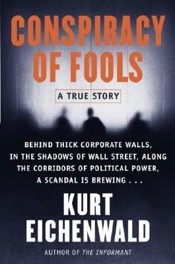Conspiracy of Fools

This is the long-form story of the collapse of Enron. It was published in 2005, which means some major events were still pending (Ken Lay died suddenly in 2006; Jeff Skilling’s trial also happened in 2006; etc).
Here’s the thing with Enron –
The company existed in a very weird field of “energy trading.” It’s all very abstract – they were basically trading futures contracts and options on different forms of services and consumables. They started in the pipeline business, but then branched out into water, broadband, electricity, etc.
At least, I think that’s what they did. Few people really know for sure. In the documentary The Smartest Guys in the Room, Bethany McLean said, “The truth is, hardly anyone knew how Enron made money.”
Hell, maybe they didn’t actually make money? As it turned out, most of their “profits” were just on paper. Actual cash flow was very poor.
The Enron scandal was a classic accounting scandal. It all revolved around how they recorded revenue, and all anyone cared about was showing profits on paper. They used “mark-to-market” accounting, which is a method of recording all the future profits of some venture up-front, which just defies all logic in the first place.
Since Enron was publicly held, they needed a watchdog, and this was supposed to be Arthur Anderson. However, AA was totally corrupted by the fact that they did a huge amount of other business with Enron and couldn’t afford to lose them as a customer. There are multiple instances recounted of AA staff being demoted, transferred, or fired because they disagreed with how Enron wanted to handle the numbers, and Enron threatened AA with loss of business.
And then there was Andy Fastow. For a period, he was the CFO of Enron, despite knowing very little about corporate finance. The book portrays Fastow as just being greedy and criminal. He created a bunch of “off-book entities” that he owned, and that would do deals with Enron. This was wildly inappropriate, and Fastow used them to enrich himself.
And then it all came tumbling down. The entire system was built around the idea that Enron’s stock price would keep going up. But, inevitably, it didn’t. It started to slip, and then 9/11 happened, which caused everything to slip.
What was it that Warren Buffet said? When the tide goes out, you can see who’s swimming naked.
The book itself is long. And it has the same tone as Too Big to Fail where it recounts every conversation in detail, providing minute details about time and place, and even the inner thoughts of participants. The author has a section where he explains the process by which he got this information, but I always struggle with this – in some places, it reads like a novel.
The chapters are long, but they’re divided up into smaller chunks, separated by whitespace. Some are just a few sentences long. The author uses this for pacing – as the “action” gets more frenetic, the narrative whipsaws back and forth between settings, sometimes jumping through the thoughts of multiple people in the same conversation, or on other sides of the same phone call.
The specifics are confusing. I tried very hard in the beginning to understand the accounting tricks, but I gave up eventually. It’s all incredibly complicated and turns on very specific points of accounting law. At some point, you just let it wash over you.
There are a lot of people. I imagine there are 300+ named people in the book. Some are long-term – Ken Lay, Jeff Skilling, and Andy Fastow are the main characters – but others just flit in and out. Often a name would pop up that I knew I had heard before, but it was, like, 300 pages ago, so I didn’t remember them. (There’s a detailed “Cast of Characters” in the front matter, but I’ll admit to no consulting it enough.)
Assuming everything is accurate, it’s a stunning work of research.
But, it’s a long-haul. Again, like Too Big to Fail and Empire, I just wasn’t sure I cared in the end.
Book Info
- I have read this book. According to my records, I completed it on .
- A hardcover copy of this book is currently in my home library.